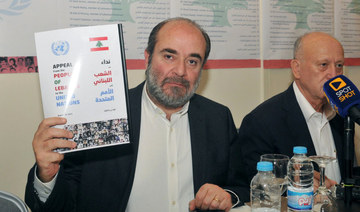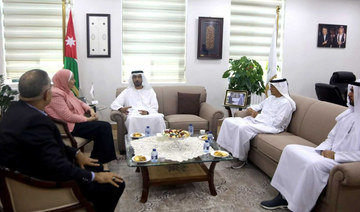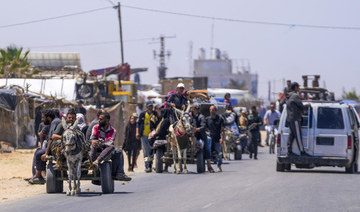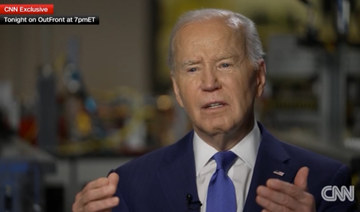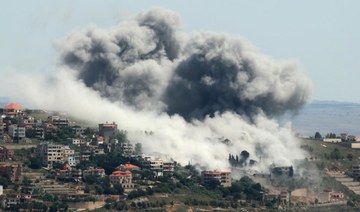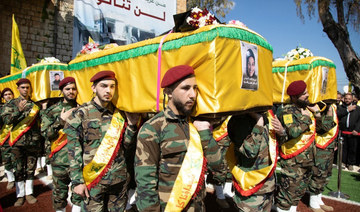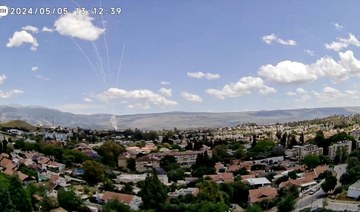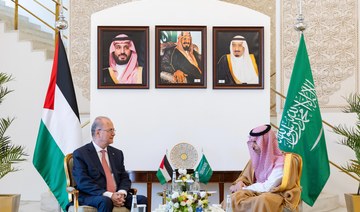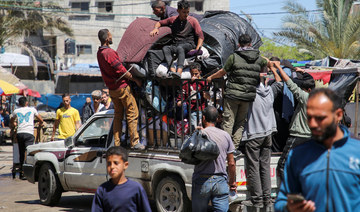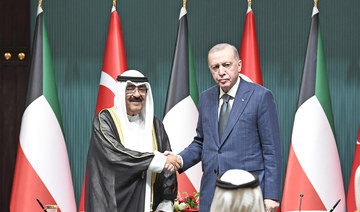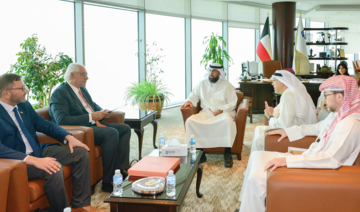BEIRUT: Anti-government protests in southern Syria have entered their second week, with demonstrators waving the colorful flag of the minority Druze community, burning banners of President Bashar Assad and at one point raiding several offices of his ruling party.
The protests were initially driven by surging inflation and the war-torn country’s spiraling economy, but quickly shifted focus, with marchers calling for the fall of the Assad government.
The protests have been centered in the government-controlled province of Sweida, the heartland of Syria’s Druze, who had largely stayed on the sidelines during the long-running conflict between Assad and those trying to topple him.
In a scene that once would have been unthinkable in the Druze stronghold, protesters kicked members of Assad’s Baath party out of some of their offices, welded the doors shut and spray-painted anti-government slogans on the walls.
The protests have rattled the Assad government, but don’t seem to pose an existential threat. They come at a time when government forces have consolidated their control over most of the country and Damascus has returned to the Arab fold and restored ties with most governments in the region.
Still, anger is building, even among Syrians who did not join the initial anti-Assad protests in 2011 that were met by a harsh crackdown and plunged the country into years of civil war.
For some, the final straw came two weeks ago when the Syrian president further scaled back the country’s expensive fuel and gasoline subsidy program. A simultaneous doubling of meager public sector wages and pensions did little to cushion the blow, as it accelerated inflation and further weakened the Syrian pound, further piling the pressure on millions living in poverty.
Soon after, protests kicked off in the provinces of Sweida and the neighboring province of Daraa.
Over the past decade, Sweida had largely isolated itself from Syria’s uprising turned-conflict although it witnessed sporadic protests decrying corruption and the country’s economic backslide. This time, crowds quickly swelled into the hundreds, calling out political repression by Assad’s government, in an echo of protests that rocked the country in 2011.
“People have reached a point where they can no longer withstand the situation,” Rayan Maarouf, editor-in-chief of the local activist media collective Suwayda24, told The Associated Press. “Everything is crumbling.”
While Assad’s political fortunes have been on the rise in recent months, life for much of the country’s population has become increasingly miserable. At least 300,000 civilians have been killed in the conflict, half of Syria’s prewar population of 23 million has been displaced and large parts of the infrastructure have been crippled. Ninety percent of Syrians live in poverty. Rampant corruption and Western-led sanctions have also worsened poverty and inflation.
In Daraa, often referred to as the birthplace of the 2011 uprising but now under government control, at least 57 people were arrested in the current protests, according to the Britain-based Syrian Network for Human Rights. Unlike in 2011, government forces did not use lethal force.
In Sweida, the response has been more restrained, with Assad apparently wary of exerting too much force against the Druze. During the years of civil war, his government presented itself as a defender of religious minorities against Islamist extremism.
Over the years, the province’s young men have also armed themselves to defend their villages from Daesh militants and Damascus-associated militias that produce and trade in illegal amphetamine pills, known as Captagon.
Joseph Daher, a Swiss-Syrian researcher and professor at the European University Institute in Florence, believes that this provides a layer of protection for protesters.
“Unlike other government-held areas, Sweida has some form of limited autonomy,” Daher said.
Meanwhile, in Damascus, Lattakia, Tartous and other urban government strongholds, some are voicing their discontent more quietly. They write messages of support for the protests on paper, take pictures of those notes on the streets of their towns, and share them on social media.
Others suffer in silence and focus on daily survival. In Damascus, some have taken to carrying backpacks instead of wallets to carry the wads of cash they need to make everyday purchases amid the rampant inflation, while families struggle to buy basic necessities.
“If I buy (my son) two containers of milk, I’d have spent my entire month’s salary,” Damascus resident Ghaswan Al-Wadi told the AP while preparing her family dinner at home after a long day at work.
The ongoing protests highlight Assad’s vulnerability as a result of the failing economy, even in areas without widespread ideologically driven opposition to his continued rule, such as Sweida.
Could the protests eventually threaten his rule?
Daher said this could only happen if the protesters banded together.
“You have forms of solidarity from other cities (with Sweida),” Daher said. “But you can’t say it would have a real effect on the regime, unless there would be collaboration between (protesters in) different cities.”
Syria protests spurred by economic misery stir memories of the 2011 anti-government uprising
https://arab.news/mf7vh
Syria protests spurred by economic misery stir memories of the 2011 anti-government uprising
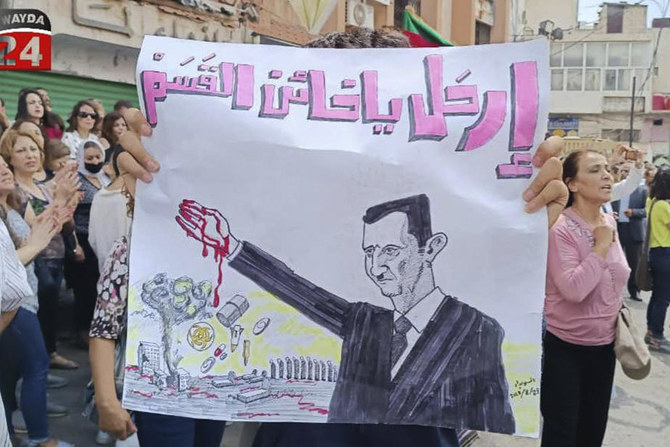
- The protests have been centered in the government-controlled province of Sweida
- The protests were initially driven by surging inflation and the war-torn country’s spiraling economy, but quickly shifted focus, with marchers calling for the fall of the Assad government
Hamas says ‘ball is completely’ in Israel’s hands in Gaza truce talks
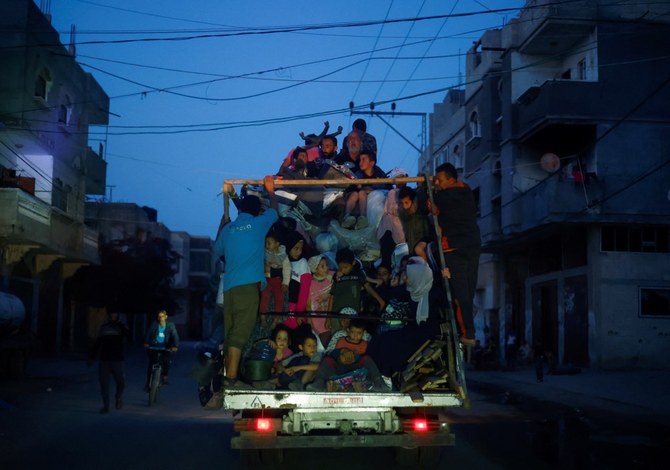
GAZA STRIP: Palestinian militant group Hamas said early Friday that its delegation attending Gaza ceasefire negotiations in Cairo had left the city for Qatar, adding the “ball is now completely” in Israel’s hands.
“The negotiating delegation left Cairo heading to Doha. In practice, the occupation (Israel) rejected the proposal submitted by the mediators and raised objections to it on several central issues,” the group said in a message to other Palestinian factions, adding it stood by the proposal.
“Accordingly, the ball is now completely in the hands of the occupation.”
State-linked Egyptian outlet Al-Qahera News reported Thursday that representatives of both camps left Cairo after two days of negotiations aimed at finalizing a ceasefire deal in the seven-month war in the Gaza Strip.
Efforts by Egypt and other mediators, namely Qatar and the United States, “continue to bring the points of view of the two parties closer together,” the outlet added, citing a high-level Egyptian source.
Hamas said Monday that it had accepted a ceasefire proposal put forward by mediators.
The deal, the group said, involved a withdrawal of Israeli forces from Gaza, the return of Palestinians displaced by the war, and the exchange of hostages held by militants for Palestinian prisoners detained in Israel, with the aim of a “permanent ceasefire.”
Netanyahu’s office at the time called the proposal “far from Israel’s essential demands,” but said the government would still send negotiators to Cairo.
Israel has long been resistant to the idea of a permanent ceasefire, insisting it must finish the job of dismantling Hamas.
Netanyahu on US threat to withhold arms: Israel will fight with its ‘fingernails’ if needed
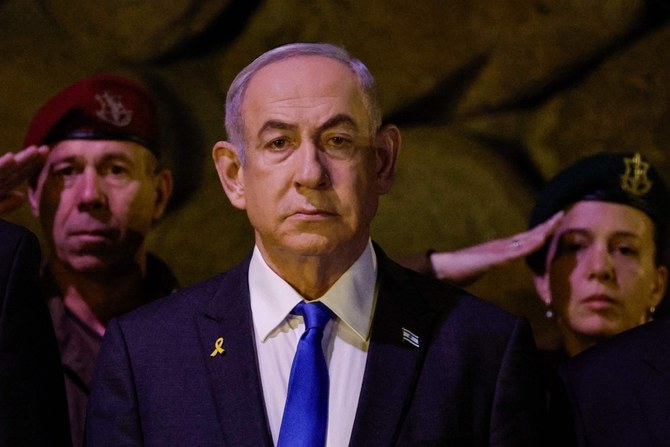
- Israel says Rafah is the last stronghold of Hamas
- Aid groups say a Rafah invasion would be catastrophic
JERUSALEM: Prime Minister Benjamin Netanyahu said Thursday that a US threat to withhold some arms would not prevent Israel from continuing its offensive in Gaza, indicating it might proceed with an invasion of the packed city of Rafah against the wishes of its closest ally.
President Joe Biden has urged Israel not to go ahead with such an operation over fears it would exacerbate the humanitarian catastrophe in the Palestinian enclave. On Wednesday, he said the United States would not provide offensive weapons for a Rafah offensive, raising pressure on Netanyahu.
But in a statement released Thursday, Netanyahu said “if we have to stand alone, we will stand alone. If we need to, we will fight with our fingernails. But we have much more than fingernails.”
Israel’s top military spokesman, Rear Adm. Daniel Hagari, also appeared to downplay the practical impact of any arms holdup. “The army has munitions for the missions it plans, and for the missions in Rafah, too — we have what we need,” he said in response to a question at a news conference.
Israel has repeatedly threatened to invade Rafah, where some 1.3 million Palestinians — over half the population — have sought refuge. The city in southern Gaza is also the main hub for humanitarian operations, which have been severely hindered by the closure of Gaza’s two main crossings this week.
Israel says Rafah is the last stronghold of Hamas and that the army must go in if it hopes to dismantle the group and return scores of hostages captured in the Oct. 7 attack that triggered the war.
In an earlier response to Biden’s decision, Israel’s far-right National Security Minister Itamar Ben-Gvir wrote a post on the platform X with a heart between the words “Hamas” and “Biden.” He and other ultra-nationalist members of Netanyahu’s coalition support a large-scale Rafah operation and have threatened to bring down his government if it doesn’t happen.
Aid groups say a Rafah invasion would be catastrophic. The UN says most of the territory’s 2.3 million Palestinians suffer from hunger and that northern Gaza is already experiencing “full-blown famine.”
Even the limited operation Israel launched earlier this week, in which a tank brigade captured the Gaza side of the Rafah border crossing with Egypt, has thrown humanitarian operations into crisis.
It also complicated what had been months of efforts by the US, Qatar and Egypt to broker a ceasefire and the release of hostages. Hamas this week said it had accepted an Egyptian-Qatari ceasefire proposal, but Israel says the plan does not meet its “core” demands. Several days of follow-up talks appeared to end inconclusively on Thursday.
Some analysts said Biden’s tough line against Israel, and the rift between the allies, threatened to weaken Israel’s negotiating position and harden Hamas’ stances. Hamas has demanded guarantees for an end to the war and a full Israeli withdrawal from Gaza as part of any deal — steps Israel has ruled out.
“It sends a discordant message at a time when Hamas is holding out on a hostage deal in the hopes that pressure will grow on Israel and it will gain a ceasefire without having to give anything in return,” said the Israel Policy Forum, a pro-Israel organization based in New York.
The war began with Hamas’ surprise attack into southern Israel, in which it killed some 1,200 people, mostly civilians, and took another 250 hostage. The militants are still holding some 100 captives and the remains of more than 30 after most of the rest were released during a ceasefire last year.
The war has killed over 34,800 Palestinians, mostly women and children, according to the Gaza Health Ministry. Israel’s offensive, waged with US-supplied munitions, has caused widespread devastation and forced some 80 percent of Gaza’s population to flee their homes.
Israel’s capture of the Rafah crossing Tuesday forced the closure of a key entry point for fuel, and it’s unclear when it will reopen. The UN agency for Palestinian refugees, known as UNRWA, said it only has enough stocks to maintain operations for a few days and has started rationing.
Israel reopened its side of the nearby Kerem Shalom crossing — Gaza’s main cargo terminal — after a rocket attack over the weekend, but UNRWA, the main provider of aid in Gaza, says aid cannot be brought in on the Palestinian side because of the security situation.
A recently reopened route in the north is still functioning, but only 60 trucks entered on Tuesday, far below the 500 that entered Gaza each day before the war.
The first aid ship bound for an American-built floating pier to be installed in Gaza departed early Thursday. But it’s unclear when that corridor will be up and running, and even then it won’t be able to handle as much aid as Gaza’s two main land crossings.
Maj. Pete Nguyen, a Pentagon spokesman, said Thursday that parts of the pier are still in the Israeli port of Ashdod awaiting more favorable seas before being moved into position off Gaza. He said the US vessel Sagamore, which left Cyprus, would transport aid to another ship, the Roy P. Benavidez, which is off the coast of Gaza.
“In the coming days, the US will commence an international community-backed effort to expand the delivery of humanitarian assistance to the people of Gaza using a floating pier,” he said.
Hezbollah attacks Israeli barracks after party members killed in drone strike
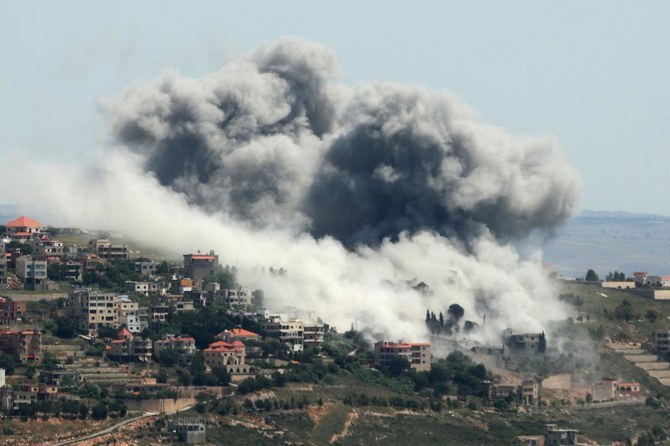
- Gallant threatens ‘open war’ against Lebanon, warns troops to prepare for ‘hot summer’
BEIRUT: Hezbollah launched several attacks on Israeli military targets across Lebanon’s border on Thursday after four of its members were killed in Israeli strikes, security sources said.
Israeli drones on Thursday had struck a car in Bafliyeh, Tyre — 99 km from Beirut — that was transporting Hezbollah members.
The group announced the death of two of its members, followed by a third who died from severe injuries.
Although Bafliyeh is located south of the Litani Line, it has never been targeted over the past seven months, making the attack a violation of the rules of engagement.
The town is located in a vital area, close to Tyre and surrounded by villages where UNIFIL forces operate.
A security source said that four Israeli drones hovered over several towns in the vicinity of Tyre and chased a car on the Bafliyeh-Arzoun road.
The drones then fired several missiles at the vehicle, destroying it.
Lebanon’s civil defense rescue force said that its members extinguished a fire inside a car that Israeli drones had struck.
It said that the bodies of the victims were pulled out of the car by the rescue force and transferred to hospital.
Hezbollah announced the death of Ali Ahmad Hamza, born in 1958, from Debaal, southern Lebanon, as well as Ahmad Hassan Maatouk, born in 1989, from the Lebanese southern village of Sir Al-Gharbiyeh.
It later confirmed the death of Hussein Ahmad Hamdan from Burj Al-Barajneh, located in the southern suburbs of Beirut.
Hezbollah responded to the assassination by striking Israeli military sites, including destroying “technical systems” developed in the Israeli Ramia outpost.
It also struck a new command center in the Natur settlement with artillery as well as a “group of soldiers in the Al-Jerdah site, killing and injuring them.”
The escalation on the southern Lebanese front coincided with further Israeli threats of open war against Lebanon.
Israeli Defense Minister Yoav Gallant said: “We will achieve our goals in the north and south. We will paralyze Hamas, destroy Hezbollah and achieve security.”
Hezbollah struck Israeli military sites and settlements in the north with dozens of missiles on Wednesday evening after Gallant visited his army’s positions in the north.
Gallant addressed the reserve forces of the 91st Division (affiliated with the Northern Command and responsible for the front with Lebanon, from Ras Naqoura to Mount Hermon) at the Branit Barracks.
The minister warned troops to be “prepared for a hot summer.”
Gallant said that Tel Aviv “is determined to return the residents of the northern areas that were evacuated amid the ongoing border confrontations with Hezbollah.”
He added that “the mission is not accomplished” in the area.
According to Israeli media, Hezbollah missiles “targeted the headquarters of the 91st Division” shortly after Gallant left.
According to an Israeli statement, Gallant, during his visit, was briefed on “operations to adapt operational activities in confronting Hezbollah forces.”
Hezbollah said in a statement that its members targeted the headquarters of the 91st Division in the Branit Barracks “with a heavy-caliber Burkan missile, causing a direct hit.”
Israeli shelling and airstrikes on the border area on Wednesday night led to the killing of five members of Hezbollah and the Islamic Jihad movement.
Hezbollah mourned Hassan Mohammed Ismail (born in 1993) from Kfarkela in the south and Mustafa Ali Issa (born in 1988) from Dlafy in western Bekaa.
Also on Thursday, the Lebanese branch of the Al-Quds Brigades — the military wing of the Islamic Jihad movement — mourned Mahmoud Mohammed Balawni, Ahmed Mohammed Halawa and Mohammed Hussein Joud from the Martyr Ali Al-Aswad Brigade — Syrian Square.
Israeli threats emerged after Lebanon received warnings from European sources about the potential for escalation in southern Lebanon over the coming months.
A political observer said that several Lebanese officials who visited Paris had conveyed warning messages regarding the situation.
In Beirut, the parliamentary foreign affairs committee listened to a report from Human Rights Watch on documented Israeli attacks on civilians in Lebanon.
MP Fadi Alame spoke of “war crimes committed, especially the deliberate shelling of journalists and the martyrdom of some, the use of white phosphorus in Gaza and Lebanon and the resulting damages, and the type of weapons used to kill paramedics.”
He said: “The government submitted a report through the Ministry of Foreign Affairs requesting the international court to conduct necessary investigations into violations and war crimes, and the foreign affairs committee is coordinating with the Ministry of Foreign Affairs to ensure the effectiveness and speed of action.
“This is Lebanon’s right to demand (compensation) for the damage incurred.”
Israel strikes eastern Rafah as ceasefire talks end with no deal
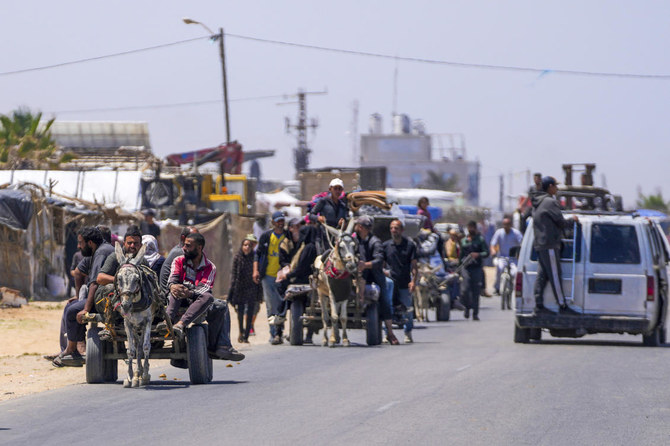
- Ceasefire talks make some headway, but no deal, say Egyptian security sources
- Israeli official said operation in Rafah to proceed as planned
- Rafah residents fear a full invasion
CAIRO/RAFAH/WASHINGTON: Israeli tanks and warplanes bombarded areas of Rafah on Thursday, Palestinian residents said, after President Joe Biden said the United States would withhold weapons from Israel if its forces mount a major invasion of the southern Gaza city.
A senior Israeli official said that the latest round of indirect negotiations in Cairo to halt hostilities had ended and Israel would proceed with its operation in Rafah and other parts of the Gaza Strip as planned.
Israel has submitted to mediators its reservations about a Hamas proposal for a hostage release deal and the Israeli delegation was returning from the Egyptian capital, the official added.
In Gaza, Palestinian militant groups Hamas and Islamic Jihad said their fighters fired anti-tank rockets and mortars at Israeli tanks massed on the eastern outskirts of the city.
Residents and medics in Rafah, the biggest urban area in Gaza not yet overrun by Israeli ground forces, said an Israeli attack by a mosque killed at least three people and wounded others in the eastern Brazil neighborhood.
Video footage from the scene showed the minaret lying in the rubble, two bodies wrapped in blankets and a wounded man being carried away.
On the city’s eastern edge, residents said a helicopter opened fire, while drones hovered above houses in several areas, some close to rooftops.
Israel says Hamas militants are hiding in Rafah, where the population has been swelled by hundreds of thousands of Gazans seeking refuge from bombardments elsewhere in the coastal enclave, and it needs to eliminate them for its own security.
One of the displaced, Mohammad Abder-Rahman, said he feared the Israeli bombardments presaged an invasion of the city.
“It reminds me of what happened before Israeli tanks stormed our residential areas in Gaza City, heavy bombardment usually allows tanks to roll toward places they intend to invade,” the 42-year-old told Reuters via a messaging app.
Ceasefire talks in Egypt’s capital made some headway but no deal was reached, according to two Egyptian security sources.
The Hamas delegation left for Doha for consultations, blaming Israel for the lack of agreement so far.
Israel has said it is open to a truce, but has rejected demands for an end to the war as it has vowed to demolish Hamas.
Biden, who says Israel has not produced a convincing plan to safeguard civilians in Rafah, issued his starkest warning yet against a full ground invasion.
“I made it clear that if they go into Rafah, ... I’m not supplying the weapons,” Biden told CNN in an interview on Wednesday.
Israel’s assault on Gaza has killed nearly 35,000 Palestinians and wounded nearly 80,000, most of them civilians, the health ministry in Hamas-run Gaza said.
It launched its offensive in response to a cross-border attack by Hamas militants on Israel on Oct. 7 in which they killed about 1,200 people and abducted 252. Some 128 hostages remain in Gaza and 36 have been declared dead, according to the latest Israeli figures.
80,000 PALESTINIANS FLEE AGAIN THIS WEEK
On Tuesday, Israeli tanks seized the Gaza side of the Rafah border crossing with Egypt on Tuesday, cutting off a vital aid route and forcing 80,000 people to flee the city this week, according to the United Nations.
“The toll on these families is unbearable. Nowhere is safe,” the UN agency for Palestinian refugees said in a post on X.
An Israeli military statement on Gaza operations on Thursday morning did not refer to Rafah.
The United States is by far the biggest supplier of weapons to Israel, and it accelerated deliveries after the Hamas attacks on Oct. 7 that triggered Israel’s offensive in Gaza. Biden acknowledged that US bombs have killed Palestinian civilians in the seven-month-old offensive.
US officials have said Washington paused delivery of a shipment of 1,800 2,000-pound bombs and 1,700 500-pound bombs to Israel because of the risk to civilians in Gaza.
Israel’s United Nations ambassador Gilad Erdan said the US decision to pause some weapons deliveries to Israel would significantly impair the country’s ability to neutralize Hamas’ power, according to Israeli public radio.
But Defense Minister Yoav Gallant told Israel’s “enemies and friends” it would do whatever necessary achieve its war aims in Gaza, underlining the scale of the standoff.
Israel kept up tank and aerial strikes across Gaza and tanks advanced in the Zeitoun neighborhood of Gaza City in the north, forcing hundreds of families to flee, residents said. The Israeli military said it was securing Zeitoun, starting with a series of intelligence-based aerial strikes on approximately 25 “terror targets.”
Deir Al-Balah in central Gaza was heaving with people who had fled Rafah in recent days. Palestinian medics said two people, including a woman, were killed when a drone fired a missile at a group of people there.
CIA DIRECTOR SHUTTLES BETWEEN JERUSALEM AND CAIRO
In Cairo, delegations from Hamas, Israel, the US, Egypt and Qatar had been meeting since Tuesday. CIA Director William Burns has shuttled between Cairo and Jerusalem, meeting Israeli Prime Minister Benjamin Netanyahu on Wednesday.
Izzat El-Risheq, a member of Hamas’ political office in Qatar, said the Hamas delegation had left Cairo, having reaffirmed its approval the mediators’ ceasefire proposal. The plan entails the release of Israeli hostages held captive in Gaza and a number of Palestinians jailed by Israel.
MEDICAL SECTOR COLLAPSED
The closure of the Rafah crossing with Egypt has prevented the evacuation of the wounded and sick and the entry of medical supplies, food trucks and fuel needed to operate hospitals, the Gaza health ministry said on Thursday.
The only kidney dialysis center in the Rafah area had stopped operating due to the shelling.
“There used to be medical aid coming in, and now there is no medical aid,” said Ali Abu Khurma, a Jordanian surgeon volunteering at Al Aqsa hospital in Deir Al-Balah.
“The entire medical sector has collapsed.”
Turkiye, Kuwait deals signal rise of ‘nonaligned axis’ in region
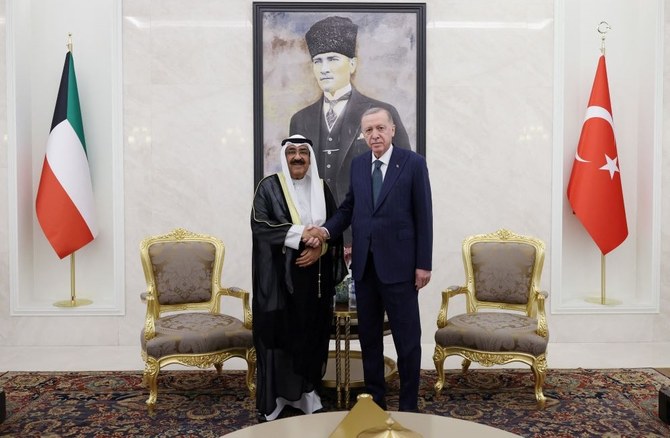
- Partnerships with Gulf countries ‘are win-win moves economically, politically’ for Ankara, analyst tells Arab News
- Visit is significant as it is Sheikh Meshal’s first to a non-Arab country since taking office in December
ANKARA: Turkiye and Kuwait recently strengthened their bilateral relations by signing six cooperation agreements in the fields of defense, trade, energy, tourism, health and diplomacy during Kuwaiti Emir Sheikh Meshal Al-Ahmad Al-Sabah’s visit to Ankara, where he was received by Turkish President Recep Tayyip Erdogan in a grand state ceremony.
These agreements, including a protocol on defense procurement and a memorandum of understanding on strategic dialogue, followed discussions between the leaders and their delegations.
The visit is significant as it is Sheikh Meshal’s first to a non-Arab country since taking office in December, and coincides with the 60th anniversary of diplomatic relations between Turkiye and Kuwait.
Eyup Ersoy, a visiting fellow in the Department of International Relations at the London School of Economics and Political Science, said that the progress in bilateral relations is bound to have an impact on regional politics.
“There is a recently revived Turkish interest in developing its relations with the states of the region which are keen to adopt a neutral position in the polarized regional geopolitics. Accordingly, there seems to be a cluster of countries in the Middle East that are trying to stay out of the entanglements of regional geopolitics,” he told Arab News.
“With the consolidation of Turkish-Kuwaiti relations, this nonaligned axis is expected to establish itself as a third alternative in the polarized region. In this regard, the signing of a strategic dialogue agreement signifies the commitment of the two states to align their regional policies.”
According to Turkiye’s Ambassador to Kuwait, Tuba Nur Sonmez, who spoke to Kuwait’s state news agency KUNA, the visit included discussions on bilateral relations and regional issues such as the Israel-Hamas conflict.
Both countries aim to increase their trade volume to $1 billion from $688 million last year, with Turkish exports to Kuwait exceeding $583 million last year. In addition, Kuwait sealed a $367 million deal with Turkish drone manufacturer Baykar to buy TB2 armed drones in 2023.
According to Ersoy, the defense industry supply agreement signed during the visit indicates a mutual interest in advancing defense industry cooperation between the two states.
“The content of the actual transactions will be determined by the Kuwaiti leadership’s assessment of Kuwait’s defense industry needs and the extent to which Turkiye could supply relevant defense industry products,” he said.
However, Ersoy said that trade volume between the two countries is not high compared with their other trading partners.
“For example, in 2022, Turkiye ranked 19th among Kuwait’s export destinations, while Kuwait ranked only 56th for Turkish exports,” he said.
“Therefore, both sides are keen to strengthen their trade relations, as indicated by the statement during the visit on the need to revitalize the Joint Economic Commission.
“In addition, Kuwait’s leadership is seeking to diversify its economy in line with its Vision 2035 strategy, as its revenues are almost entirely based on the export of hydrocarbons. Increased trade with Turkiye has the potential to contribute to this ambitious macroeconomic goal,” Ersoy said.
Kuwaiti direct investment flow in Turkiye, which stood at $2 billion last year, has also continued, reaching $1.5 billion so far this year.
“More Kuwaiti participation in the Turkish economy, especially through direct and portfolio investment, is imminent,” said Ersoy.
Kuwait is also expected to take steps to reduce its trade imbalance with Turkiye, he added.
In the tourism sector, Istanbul broke a 10-year record last year with a surge of Gulf tourists visiting the city. Trabzon, Bodrum, and Izmir are other top destinations for Kuwaiti tourists visiting Turkiye during the summer.
However, Arab visitors have been the targets of sporadic attacks amid anti-Arab sentiment in Turkiye. Last year, a Kuwaiti tourist was attacked in the northern city of Trabzon.
Betul Dogan Akkas, an assistant professor of international relations at Ankara University, said bilateral relations between Turkiye and Kuwait were based on mutual respect and trust, stemming from a historical and diplomatic legacy.
“There is capital in these relations to promote cooperation, especially in the economic sphere, including the defense industry,” she told Arab News.
“Kuwait is open to consolidating its trade, and for Ankara, partnerships with Gulf countries are win-win moves both economically and politically.
“The key aspect in analyzing these relations is the current willingness of both sides to build long-term goals. So far, we have seen mostly reactionary or short-term economic and political moves,“ Dogan Akkas said.
“Now is the right time for relations to institutionalize diplomatic capital. This requires leadership support, and both parties have it, as the emir of Kuwait visited Turkiye as his first non-Arab trip.”
Dogan Akkas also believes that the level of success and structure of political decision-making are crucial to strengthening relations.
She said that Turkiye’s ambassador to Kuwait is using her position to “achieve a comprehensive and well-structured long-term goal.”
Another question about this visit is the significance of its timing.
Ersoy believes that the Turkish president’s recent visit to Iraq appears to have eased a source of tension in Gulf politics by demonstrating Ankara’s willingness to cultivate more constructive and cordial relations with a critical neighbor of Kuwait.
“Turkiye’s receptiveness to regional political dialogue and economic prosperity has shaped the Kuwaiti leadership’s assessments in strengthening Kuwait’s ties with Turkiye,” he said.
Kuwait recently showed unease at being left out of the development road project linking Iraq to Turkiye and the Gulf states. During Erdogan’s recent visit to Iraq, Ankara secured the signing of a quadrilateral memorandum of understanding between Iraq, Qatar, the UAE, and Turkiye.
However, the project, which will significantly boost regional transport, will be launched from Iraq’s Faw port, adjacent to Kuwait’s Mubarek port, whose delayed completion has been criticized in Kuwait.
But there was no mention of this unease during the visit to Ankara.
In addition, Ersoy said, national security imperatives appear to have contributed to the recent visit.
“Kuwait’s neutrality in the regional struggle does not guarantee immunity from coercive diplomacy or punitive strategies in a militarized and highly volatile region,” he said.
“Therefore, exploring and building a security partnership with Turkiye appears prudent for the Kuwaiti leadership, which is another reason for the recent high-level visit.”
In this context, Dogan Akkas underlined the importance of the regionalizing their cooperation.
“If Kuwait and Turkiye take their cooperation to a regional or subregional level, as leaders in certain regional affairs, the political capital will be properly implemented,” she said.



